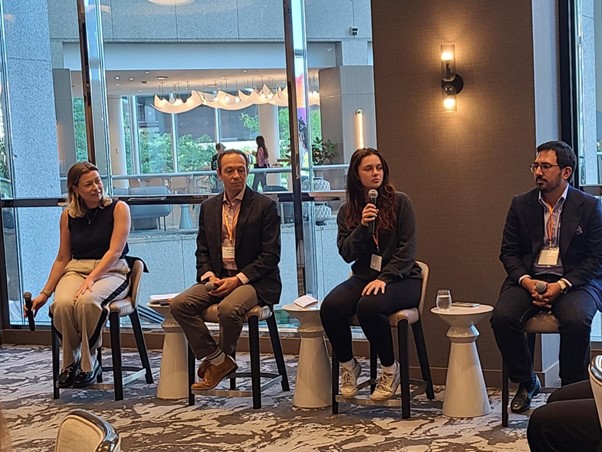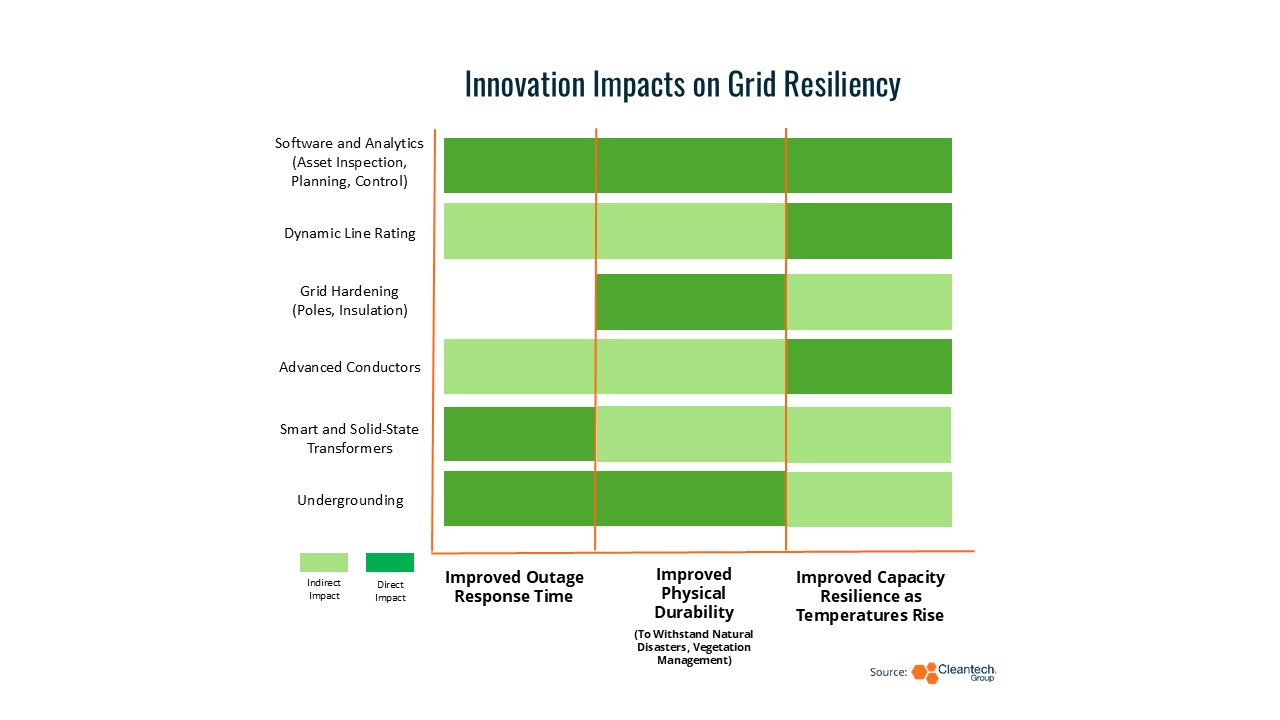Adaptation and Resilience: New Innovation & Venturing Opportunities for a 2° World
Climate change is here and the longer we leave adaptation, the more expensive and difficult resilience is. Because of this, Cleantech Group is intentionally focusing on innovation for adaptation and resilience against climate-related risks. Our research team has been hard at work dissecting topics including grid resilience, crop inputs, wildfire resilience, and climate risk analysis systems.
This research culminated on the 10th of September, where we hosted a 1-day event in Boston focused exclusively on adaptation and resilience, bringing together local leadership and the innovators most poised to offer solutions to adaptation and resilience challenges.
Here are some of the highlights.
Adaptation & Mitigation Funding
Investments into adaptation technologies currently make up only 4-5% of global cleantech funding, emphasizing the urgent need for investment in these areas.
While mitigation often takes center stage, adaptation remains a side topic in many discussions. This is concerning because the cost of adaptation is expected to skyrocket. By 2030, the annual financing gap for adaptation could reach a staggering $212B.
Currently, most adaptation funding comes from governments and public institutions. Private sector involvement, which will be the ultimate deciding factor, is still lagging.
Focussing on some key areas for discussion, here are some key takeaways from the event including energy, agriculture, insurance, and drought resilience technology ecosystems:
Insuring Against Climate Risk
Joined by Christopher Lowell, Managing Director of InnSure; Valkyrie Holmes, CEO of Faura, and Peter Ortez, Principal at Munich Venture Partners, we discussed how the insurance sector worked with innovators and how innovation can transform the sector:
- Insurance isn’t one homogenous sector — when it comes to innovation, they are demand owners, enablers, innovators, investors, and also BLOCKERS.
- Quantifying physical climate risks can enable hyper-personalization of personal lines of insurance, enabling greater policyholder engagement and RISK REDUCTION.
- Climate risk causes liability risks which will further accelerate demand for innovative solutions.
- Insurance incumbents are growing but Insuretechs are growing faster!
Overall, the one-day event highlighted adaptation as more than just an adjustment to climate change — it’s also a catalyst for decarbonization. While mitigation remains vital, adaptation is essential to reduce risks and build resilience against the inevitable impacts of climate change. As the world faces increasing climate risks, these conversations spotlighted the multi-trillion-dollar opportunities available to those ready to invest in a healthier, fairer, and more resilient future.

Building a Climate-Ready Grid
Moderated by Cleantech Group’s Zainab Gilani, Associate, Energy & Power, this panel featured a diversity of speakers working across grid resilience including Sander Cohan, Head of Innovation from National Grid Partners, David Miller, Managing Partner at Clean Energy Ventures, Jessica Harrison, Executive Director at VEIR, and Mishal Thadani, CEO at Rhizome.
Key takeaways include:
- Dynamic Line Rating (DLR) solutions are incredibly relevant in conversations about creating a more resilient grid, especially as weather patterns fluctuate and temperatures increase nationwide. DLR allows utilities to adjust the power-carrying capacity of a transmission line in real time and adjust to real time weather patterns.
- Mishal Thadani discussed the importance of utilities to understand and calculate risk especially as the number of extreme weather events and weather-related outages increased dramatically in the last decade. Rhizome’s platform leverages AI, historical climate data and future weather forecasts to identify vulnerabilities and help utilities plan investments around this data to create a more resilient system.
- VEIR also discussed the importance of improving transmission capacity using their system which leverages high temperature superconductors and a novel cooling system to allow transmission capacity to increase 5-10x compared to traditional conducting lines. Their cooling systems also prevent sag, which is a challenge other conducting lines face as temperatures rise.
Given the importance the grid has in distributing energy to businesses, homes, hospitals and other essential services it’s critical that innovations and solutions related to improving grid reliability are adopted. The grid needs to adapt to changing climates and weather patterns and avoid potentially catastrophic outages.

Crop Science Innovation: Key to a Climate-Resilient Food System
Cleantech Group Consultant Gabriella Rufo moderated a panel with Josh Speros, Investment Manager at BASF and Tom Meade, Chief Science Officer at Enko Chem. Kicking the panel off, Gabriella outlined some key research findings to set the scene in crop resilience:
- Crop science innovations’ North Star is to grow enough cheap, healthy food for more people without harming nature.
- Crop production needs to almost double by 2050 to meet rising food demand, but at the same time, there needs to be a balance between increasing agricultural production for long-term food security and minimizing environmental impacts.
- Crop science for adaptation is complicated, with a toolbox of technologies improving how crops withstand impacts of climate change, intake nutrients to boost yields, and protect against pests, weeds, diseases, and severe weather conditions.
Highlights from the discussion:
- Speed of discovery is taking off – start-ups like Enko are cutting the time to bring novel crop inputs to market by up to 75% with its AI-driven model.
- Bringing farm innovations to life is an uphill battle as old-school R&D and strict regulations slow the journey from lab to field.
- Start-ups’ agility, free from legacy research investment, allows them to reimagine pesticide discovery, experiment with novel chemistries, leverage cutting-edge tools, and quickly adapt to changing market conditions and farmers’ evolving needs — giving them a distinct edge over corporate giants.
- Market adoption hinges on making these solutions affordable for farmers around the world and as easy as possible to understand, use, and integrate into the farming process.
- In countries like Japan, where farming faces an aging workforce and shrinking arable land, precision agriculture emerges as the game-changer — leveraging AI, drones, and data analytics to boost efficiency, reduce workload, and attract tech-savvy talent to the fields of tomorrow.
- Pharma-inspired techniques are revolutionizing herbicide discovery, allowing rapid screening of billions of molecules for targeted, safer weed control solutions.
- Creating and using more fertilizers and pesticides won’t solve the problem — we also need innovation to make the actual production of agrochemicals more sustainable. BASF’s new fermentation plant in Germany is bringing innovative biological fungicides and seed treatment solutions to market using a manufacturing process with lower energy intensity based on renewable raw materials.
Taming the Dry Spell: Innovative Solutions for Water Scarcity
Joined by Veronique Bourgier, Vice President at Veolia North America, Christopher Kurth, Chief Technology Officer at Aqua Membranes, Snehal Desai, SVP & Chief Growth and Innovation Officer at Xylem, and Taylor Evans, Sr. Innovation Manager, Financing at Imagine H2O, we discussed the opportunities in innovation for drought and key market dynamics.
Key takeaways from the panel were:
- As we ebb closer to a water crisis for 4 billion people by 2030, growing industries such as electrolyzers, biogas, and hydrogen will also increase water demand. However, these are the industries that have the available capital to pay for and scale water innovation.
- Large corporates continue to make public commitments to reduce and improve water use but few have a strategy in place to meet their goals.
- Water reuse is our best friend when tackling water scarcity.
- Many solutions to water scarcity problems involve stacking existing technologies and overlaying with AI or Digital Twins.
- Water system flexibility is adaptation providing resilience against changing water quality due to altered/extreme weather events.
- The hottest innovations for investment at the moment are providing crisis-driven solutions (e.g., PFAS), waste-to-value solutions such as methane capture from wastewater, or utilizing AI for system efficiency.
New technologies can help us shift from simply reacting to climate events to proactively preparing for them. This is particularly important in sectors like insurance, which are already feeling the heat (literally) from climate risks. While insurers are adapting out of necessity, many other vulnerable industries are not.
The need for innovative adaptation solutions is clear. More risk-sharing between demand owners and developers of novel technologies is likely to be a critical enabler of confidence in business models underpinning adaptation technologies and can help unblock the financing barriers.
Todd Allmendinger, Director of Research and Consulting at Cleantech Group, and Emilie Mazzacurati, Co-Founder of Tailwind, discuss the clear need for innovation solutions simply to minimize risk, and make our cities, our homes and businesses, and our food, energy and industrial systems more resilient.



